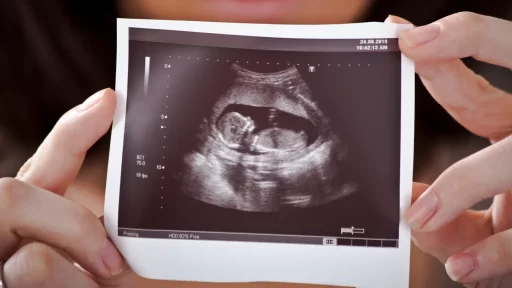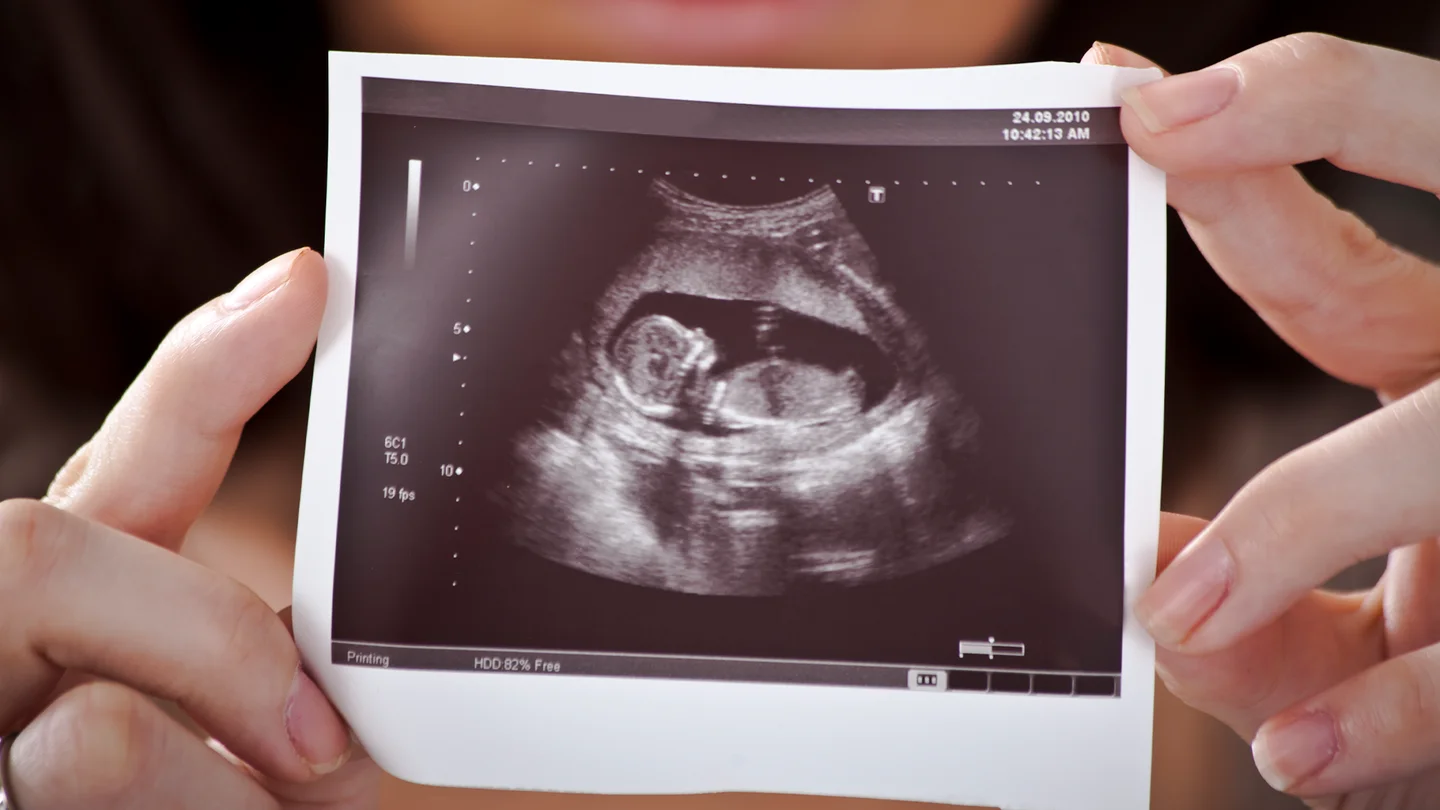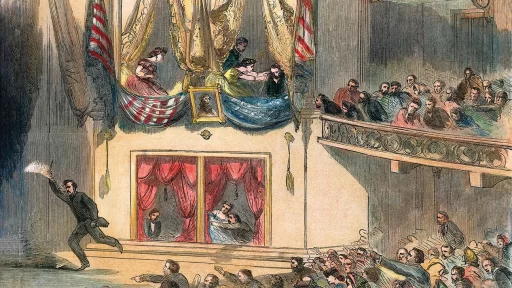Innocent and vulnerable babies are the obvious victims of partial-birth abortion, for life is deliberately and brutally extracted from their defenseless little bodies. In a political and social environment that is actively seeking to discover, acknowledge and protect new “victim” special interest groups, there exists no greater example of legitimate victimization than the helpless and voiceless babies who succumb to the powers of “judicial progressivism“, “medical care“, “social compassion“, and “gender justice“.
The battle to save these victims of a barbarous ideology is raging more intensely now than at any time since the dawn of the arbitrary creation of abortion “rights” in 1973. The battle has shifted its focus from courts and clinics to legislatures, although judges are still significant figures in the fight to preserve abortion rights. The epicenter of the abortion conflict is the battle to enact The Partial-Birth Abortion Ban Act of 1997 into law. The bill was passed by both houses of Congress, vetoed by President Clinton, and is awaiting a Congressional attempt to override the Presidential veto sometime next year.
I am confident the people will prevail through the legislative process as the truth about the brutalization of “almost born” babies becomes clear to the general public. This will be the ultimate outcome even though activist judges are already attacking the constitutionality of partial-birth abortion bans (the Ohio ban was struck down by the 6th Circuit Court of Appeals). A final victory in the “Battle of the Ban” will likely require a showdown of some sort between legislative authority and judicial authority. The outcome of that probable showdown will have far reaching implications beyond the immediate issue of partial-birth abortion. It will set the stage for future encounters contesting other components of the liberal social agenda being promoted by an activist judiciary.
A ban of partial-birth abortion will probably not save many lives, for most of those who were victims of the partial-birth procedure will simply become victims of other savage methods of abortion. The ban will, however, slow the momentum with which our culture is denigrating the sanctity of human life.  To change direction one must first come to a stop, and a ban is a definitive stop sign, a line of demarcation beyond which law forbids any trespass.
To change direction one must first come to a stop, and a ban is a definitive stop sign, a line of demarcation beyond which law forbids any trespass.
However important the obvious and immediate victim mentioned above, there are other victims that are suffering grievous injury at the hands of partial-birth abortion. Although they are more obscure, the battle of the ban is a crusade to save these victims as well.
VICTIM # 2: Maternal Love
Mother Teresa, at the National Prayer Breakfast in 1994, in forceful, uncompromising language, wrenched open the closet and uncovered hidden victims of the abortion culture. The audience was stunned by her message, especially the abortion ideologues present. She proclaimed unequivocally, “I feel that the greatest destroyer of peace today is abortion, because it is war against the child—a direct killing of the innocent child—murder by the mother herself. And if we accept that a mother can kill even her own child, how can we tell other people not to kill one another?” [1] Her barrage of knockout oratory continued, “So abortion just leads to more abortion. Any country that accepts abortion is not teaching the people to love, but to use any violence to get what they want. That is why the greatest destroyer of love and peace is abortion.” [2] The heart of her piercing message is that “love” itself, especially maternal love, has fallen to the abortion advocacy sword (or Metzenbaum scissors and suction catheter—Dr. Martin Haskell’s instruments of choice [3]). Now, three years later, the courageous crusader has gone to heavenly bliss where love and peace abide, unmolested. Here, however, abortion is still taking its toll. With the ascendancy of the “right” of maternal “choice,” we are witnessing an increase of alternative maternal choices, also devoid of maternal instinct, whereby full fledged infanticide is following on the heels of four-fifths infanticide. [4] As love and peace are poised on the precipice of cultural oblivion, the battle of the ban rages on. And Mother Teresa, a disciple and profound purveyor of His love, finally rests in peace.
VICTIM # 3: The Constitution
There are many foundational principles contained within the Constitution of the United States. Two in particular are severely threatened by the advancement of the abortion agenda by judicial decree.
Abortion is not the only social/moral issue being promoted by activist judges that threaten these foundational principles, but it is the preeminent one because of the magnitude of its moral and legal implications.
Government by the Consent of the People
Our Constitution begins with an explosiveness unparalleled in the history of constitutions. The resounding words, “We the People…,” declares emphatically the first and foremost of the Constitution’s foundational principles.
Our Constitution opens with a forthrightness and simple eloquence that echoes with a shout the convictions of numerous predecessors: The Magna Carta and English Common Law tradition, the State Constitutions during the founding era, and the Founding Fathers themselves, among others. [5] Alexander Hamilton in Federalist Paper # 22 summarized this political principle: “The fabric of American empire ought to rest on the solid basis of the consent of the people. The streams of national power ought to flow immediately from that pure, original fountain of all legitimate authority,” [6] and James Madison in # 46 does likewise, “The adversaries of the Constitution seem to have lost sight of the people altogether in their reasonings on this subject…They must be told that the ultimate authority, wherever the derivative may be found resides in the people alone.” [7]
In one mighty swing of arbitrary power, the Supreme Court decision in Roe v. Wade felled the “consent of the governed” principle on a state and a national level, first by nullifying abortion law in all fifty states, [8] and second, by failing to find Constitutional authority to do so. [9] Edwin Meese, former U.S. Attorney General, addresses this legal travesty when he writes, “One of the most pernicious aspects of the Roe decision is that it removed one of the most profound social and moral issues from the democratic process without any constitutional authority. For the first two centuries of America’s existence, the abortion issue had been decided by state legislatures, with substantially less violence and conflict than has attended the issue since the Roe decision.” [10] Thomas Sowell indicts the audacity of Roe v. Wade when he writes that “in striking down state abortion laws…judges do not bind themselves to enforcing rules made by others, even when the historical meanings of those rules are quite clear, but feel free to evade such rules by ‘interpretations’ based on broader social philosophies or a sense of cosmic justice.” [11]
According to a broad based coalition of religious leaders in America, this principle as found in both the Constitution and the Declaration has been extensively undermined by the legalization of abortion. “Our nation was constituted by agreement that ‘we the people,’ through the representative institutions of republican government, would deliberate and decide how we ought to order our life together. In recent years, that agreement has been broken. The Declaration declares that ‘governments are instituted among men, deriving their just powers from the consent of the governed.’ In recent years, power has again and again been wielded, notably by the courts, without the consent of the governed.” [12]
The coalition goes on to clarify that Roe v. Wade is not the only Court decision to exhibit judicial hostility to “government by the consent of the governed.” [13] Roe v. Wade was not an aberration in Court policy, but part of a policy pattern generated by the evolution of a new judicial worldview.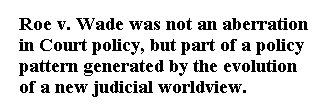
The Partial-Birth Abortion Ban Act of 1997 is a legislative attempt to reverse this trend of ignoring the will of the people, and their fundamental authority within our political system. Because “the consent of the governed” is conveniently forgotten in many ways, by many levels, branches and facets of government and its bureaucracy, this “ban” will do very little to restore the people to their rightful place of authority. Indeed, this ban on partial birth abortion will be merely a single “baby” step at the beginning of a long and arduous journey toward restoring American founding principles to our contemporary political environment.
Government with the Separation of Powers
The primary way by which the Constitution divides and diffuses power is through the establishment of three separate and distinct branches in the federal government. The genius and efficiency of this diffusion of political power is enhanced by integrating inter-branch checks and balances. The structure of the Constitution implies and the 9th and 10th Amendments specify two additional forms of separation of power: 1) between the people and the government, and 2) between the state governments and the federal government.
The Constitutional principle of “Separation of Powers” is being violated in many and diverse ways by all three branches of government. Our concern here is to evaluate one particular transgression of this principle: when the federal judiciary usurps the powers and prerogatives of legislatures.
The anti-federalists who opposed the ratification of the Constitution anticipated just such a usurpation of authority. Hamilton in Federalist Paper # 81 summarizes the anti-federalist fear in this way: “The authority of the proposed Supreme Court of the United States, which is to be a separate and independent body, will be superior to that of the legislature. The power of construing the laws according to the spirit of the Constitution will enable that court to mould them into whatever shape it may think proper; especially as its decisions will not be in any manner subject to the revision or correction of the legislative body. This is as unprecedented as it is dangerous.” [14] Hamilton proceeds with presenting his defense of the Constitution, with a somewhat casual conclusion, “Why worry!?” Why worry, indeed! The anti-federalist could not have been more astute if he had been witnessing the contemporary judicial juggernaut firsthand.
In fairness to and defense of Hamilton, there are Constitutional means by which Congress can keep in check an out of control Court. But it requires courage and conviction. Proponents of the Partial-Birth Abortion Ban Act of 1997 claim it will not disturb the authority of Roe v. Wade, [15] and in addition, I believe it will not directly change the trend away from a Constitutional separation of powers. But if Congress wins the “Battle of the Ban,” a test case will likely make its way to the Supreme Court, testing its constitutionality. If the Court then overturns and nullifies the “Ban Act,” we could very well witness an all out war between the Congress and the Court over the principle of “separation of powers.” One almost hopes for such a scenario, for it may be the very catalyst needed to nurture further courage and conviction on Capitol Hill.
VICTIM #4: The Declaration of Independence
It would be a grave mistake to allow our political institutions to disassociate themselves from the fundamental principles contained within the Declaration of Independence. It is as much a part of our political heritage as the Constitution and must be equally respected as one of our nation’s founding documents. Without its principles the Constitution stands on unstable and unpredictable ground. Abortion in general, and partial-birth abortion in particular, have waged a direct frontal attack against foundational principles contained within our nation’s birth certificate and corporate charter.
The Law of Nature and of Nature’s God
Our Founders believed “the law of nature and nature’s God” was a higher law than human law and a higher authority than human authority, and they therefore appealed to this higher law at the beginning of the Declaration of Independence. This higher law, to which the Founders appealed, was our nation’s original source of “entitlements.” This higher law “entitled” them to take political action and declare independence. Today, this higher law is an abomination to judicial “law makers” who desire to re-create law in their own image.
Our Founders understood this phrase to mean “God’s law revealed through nature and His moral law revealed in the Bible.” [16] Gary Amos in “Defending the Declaration,” explains further, “In the Christian common law tradition of England from Bracton (d. 1268) to Blackstone (c. 1760’s) the term ‘law of nature’ meant the eternal moral law God the Creator established over His created universe. It was a technical term for ‘creation law’—the original scheme of things purposed or willed by the Almighty.” [17]
Our Founding Fathers were necessarily appealing to a law that could legitimately supersede all law to which they had previously appealed. They “were in a position of last resort. They could no longer rely on the constitution of England or on English law, nor could they stand on their rights as Englishmen. There was no English judge to hear their case. So they appealed to a greater constitution, a greater law, a greater judge, and a greater system of rights.” [18]
The social engineering that currently preoccupies the judicial powers that be would wither under the scrutiny of “the laws of nature and nature’s God.” For that reason, there is a considerable aversion to acknowledging its existence, and proclaiming a belief in such higher legal authority has become risky for judges who care about career advancement (consider the case of Clarence Thomas).
An important part of our political heritage is vanishing before our eyes, as our political institutions increasingly promote policies in fundamental opposition to “the laws of nature and nature’s God.” There is a growing concern that we have reached a crisis point in our history, not unlike that which faced the Founders in 1776. There is a growing conviction that action is required, and that “the law of nature and nature’s God” will be the jurisdictional authority that authenticates the action.
“When in the course of human events, it becomes necessary….” [19] It was necessary in 1776 to appeal to “the law of nature and nature’s God.” It is again necessary to appeal to this preeminent law that formed the basis for our nation’s birth. Our nation’s survival depends upon it. Our legislators and judges must be confronted boldly by the people. The political agents of the people must be challenged to acknowledge higher law than human law. Lawmakers (and pseudo-lawmaking judges) must be compelled to submit to the authority of “the law of nature and nature’s God.” The Partial-Birth Abortion Ban Act of 1997 is a step toward re-establishing political accountability to this higher legal authority.
Self-evident Truth
The existence of self-evident truth is assumed by the Founders. Gary Amos summarizes Thomas Aquinas’ definition of self-evident truth: “…man is not the source of self-evident knowledge, God is. Certain things become self-evident to man because God has created man in His own image and inscribes the requirements of His law on man’s heart in spite of man’s sin. Certain truths are evident in men’s selves, because God makes it evident by promulgating it to them.” [20]
Self-evident truth is truth “so clear and obvious to the ordinary person that [it requires] no proof.” [21] The Declaration proclaims pointedly what truths the Founders assumed to be self-evident: 1) all men are created equal, 2) God has given all men certain inalienable rights–three of which are life, liberty and the pursuit of happiness, 3) governments are instituted by the consent of the people for the express purpose of securing the inalienable rights of the people, and 4) it is the right of the people to change or replace the government if it fails to fulfill its express purpose for being.
A coalition of religious leaders in America self-described as, “Catholics, Orthodox, and Protestants of differing conviction on many issues…conservatives and progressives of various ethnic and racial identities and with differing political views,” [22] made this incisive observation pertaining to these foundational principles in the Declaration: “Invoking ‘the law of nature and of nature’s God,’ the Founders declare, ‘We hold these truths to be self-evident…In recent years it has become increasingly manifest that these truths cannot be taken for granted. Indeed, there is ominous evidence of their rejection in our public life and law.”[23]
The Right to Life and the Right to Liberty
Self-evident Truth # 2 (God given inalienable rights) is of particular interest because it is central to the debate on abortion and the “battle of the ban.” Steve Forbes, in “The Moral Basis of a Free Society,” makes the connection between this self-evident truth in the Declaration and the contemporary cultural war. “The Founding Fathers staked the future of the country on the principle that human beings are created by God, and therefore have certain intrinsic, absolute, non-negotiable rights.” [24] “In America today, however, not everyone regards these basic moral truths as ‘self-evident.’ Modern liberalism, which rejects absolute moral standards, has abandoned the proper ordering of man’s fundamental rights. As a result, modern liberalism has undermined a long-held American principle: that the law should protect the weakest among us, not just the strong, the healthy, and the rich. Abortion and euthanasia violate this principle by removing the protection of the law from society’s most vulnerable members.” [25]
If pressed on the issue of inalienable rights, proponents of abortion and opponents of the partial-birth abortion ban would prefer to focus on “liberty” to the exclusion of “life.” They have chosen to frame the issue in the appealing rhetoric of “rights” and “freedom,” and wish to ignore the competing and compelling “right to life.” However, the strategic use of the language of liberty in the context of abortion rights, is less than honest and far from accurate. Religious leaders address this abuse of language by explaining, “Liberty is not license but is ‘ordered liberty’—liberty in response to moral truth. The great threat to the American experiment today is not from enemies abroad but from disordered liberty. That disorder is increasingly expressed in a denial of the very concept of moral truth.” [26]
There are several problems with the way abortion advocates exploit this concept of “liberty.” One problem relates to interpretation of the concept itself and the others involve the application of the concept in society (when it is applied and how it is applied). Forbes analyzes these problems with perceptive insight: “The order of these rights—first life, then freedom, and then the equal opportunity to pursue one’s own happiness—was written with great care and precision, not haphazardly. The Founders understood the need to balance man’s right to be free with man’s responsibility to be honest, just and fair. For example, if it makes you happy to shoot and kill someone while you rob a bank—well, the law says you’re out of luck. A person’s right to live supersedes your “freedom” to steal and murder. This may seem obvious, but it is profound.” [27] Though it may be obvious (perhaps even self-evident), it seems to escape those who do not see how it applies to the conflict of competing interests between the “freedom” of abortion choice and a baby’s right to “life.” Their selective application of the concept of liberty is evident when they demand freedom involving abortion choices (i.e., child abuse), but deny freedom when it involves male assertiveness (i.e., sexual harassment). Comparatively, it is clear which form and expression of “freedom” is the greater violation of someone else’s inherent rights. A double standard definitely exists. They resort to arbitrary application for the sake of ideological preservation.
The Missouri Synod of the Lutheran Church speaks against this blatant distortion of liberty: “American society has adopted a distorted definition of freedom. Freedom focused only on the self and its rights. Freedom from the bonds of community. Freedom from duties of parents to children…The ultimate and inevitable outcome of this new freedom is the individual’s private, autonomous power to choose life or death, for self or even for others. This is the concept of freedom behind the increasing acceptance of euthanasia and infanticide in American society. This new freedom finds its broadest, most blatant expression in abortion.” [28] A religious coalition joins the chorus of those opposing this redefinition of liberty: “This is the very antithesis of the ordered liberty affirmed by the Founders. Liberty in this debased sense is utterly disengaged from the concepts of responsibility and community, and is pitted against the ‘laws of nature and of nature’s God.’ Such liberty degenerates into license for the oppression of the vulnerable, while the government looks the other way, 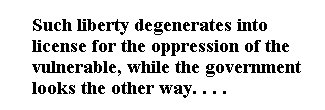 and throws into question the very possibility of the rule of law itself.” [29]
and throws into question the very possibility of the rule of law itself.” [29]
Doug Bandow also addresses this problem of emphasizing “liberty” to the neglect of “life.” He writes, “The issue remains a difficult one given the importance of the competing values—life and liberty—at stake. But to fail to hold people responsible for the consequences of their actions does more than undermine the sanctity of life. It also fails to treat liberty seriously. Freedom matters because it allows people to control their own lives and bear the consequences of doing so…Of course, the courts have made it difficult to hold individuals accountable for their decisions. In the name of a Constitution that protects life and liberty, the judiciary has prohibited government from protecting life and enforcing the responsibility that naturally accompanies liberty.” [30]
The Partial-Birth Abortion Ban Act of 1997 is an effort to halt the expansion of spurious “rights” and “liberties.”
The Campaign to Ensure the Demise of These Victims
The campaign to preserve unrestricted abortion rights, to protect the partial-birth abortion procedure and to perpetuate the demise of abortion’s varied victims is being advanced from four major fronts. They are: 1) the Judicial Branch, 2) the Executive Branch, 3) the Media, and 4) Pro-Choice Advocacy Groups. Since the role of the judicial branch has already been discussed, observations here will be limited to the last three of these.
The Nature of the Campaign
The campaign strategy utilized by the executive branch, the media and abortion advocacy groups have several characteristics in common. Disinformation (mis-representing the facts and issues) is one of the foremost methods practiced by these three groups, especially with regard to The Partial-Birth Abortion Act of 1997.
In virtual unison they promulgated distortions about the partial-birth abortion procedure: 1) it is an extremely rare method, 2) it is performed only during the third trimester of pregnancy, 3) it is performed only in cases where there are serious health problems with the fetus and/or serious health risks for the mother (i.e. life or future fertility endangered), and 4) it is performed only on a dead fetus (from natural causes or anesthesia overdose). These distortions were uncovered, with extensive documentation, in Congressional hearings. [31]
Disregarding evidence is another method used to cloak the truth and sustain the campaign. [32] It is commonly used in conjunction with disinformation. They’ve repeatedly ignored papers, interviews, and testimony of two prominent abortionists (Dr. Martin Haskell and Dr. James McMahon) who developed and used the partial-birth abortion procedure. Also ignored is the testimony and evidence presented by Physicians Ad Hoc Coalition for Truth, a group of over 400 physicians and professors or specialists in obstetrics, including former Surgeon General C. Everett Koop. Abundant information that would clarify issues and dispel misunderstandings was readily available to all interested parties, but it was apparently suppressed in favor of the strategy of disinformation.
Distraction (drawing attention away from primary issues and vital facts with rhetorical wizardry) is a third method commonly used for crisis management (damage control) purposes. This technique is a delay tactic, employed to thwart public understanding and control/direct public opinion. This also is used in conjunction with the disinformation tactic.
Because the truth about partial-birth abortion is so shocking and abhorrent, the utilization of these methods became crucial campaign strategies. Without the somewhat successful implementation of these methods, outraged public opinion would have flooded government offices so overwhelmingly, surely three additional Senators would have been persuaded to change their votes and would have made the Presidential veto of the Partial-Birth Abortion Ban Act a mute point.
The Crusade to Save the Victims
Considering the strategy used by those who oppose the Partial-Birth Abortion Ban Act, the most important counter measure that can be employed by those crusading to save the victims of partial-birth abortion is information dissemination. Uncovering the truth about partial-birth abortion and proclaiming it from every possible rooftop is the primary strategy proponents of the ban are using to fight the good fight. Many and diverse Christian advocacy groups are participating in publicizing the facts about partial-birth abortion. They include: Focus on the Family, Family Research Council, Christian Coalition, Concerned Women for America, The American Family Association, Eagle Forum, The National Right to Life Committee, Ethics and Religious Liberty Commission of the Southern Baptist Convention, The Lutheran Church—Missouri Synod, [33] and a Coalition of Catholic, Orthodox, and Protestants. [34] The goal of these groups is to saturate society with truth about partial-birth abortion, including elected officials, resulting in change: first, in public opinion; next, in legislative direction; third, in legal content; and finally in cultural values.
We are finally seeing signs of legislative perseverance in the abortion issue arena. For the second consecutive year Congress has passed a Partial-Birth Abortion Ban Act, only to have it vetoed by President Clinton. This signals the adoption of a Wilberforce-like [35] willpower. And, it appears, Congress has embraced this cause with a Churchillian determination that will “never, never, never give up. It is essential that Congress be willing to carry on this crusade indefinitely; as long as it takes to achieve just and lasting law. The opposition is strong and determined. Those fighting to save the victims of partial-birth abortion must be also, and more so.
Calling All Christians to Join the Crusade
I was deeply moved and profoundly challenged by “That They May Have Life: A Statement of the Lutheran Church—Missouri Synod.” [36] Their statement contained a clarion call to action. It was a provocative summons to Christians everywhere (including politicians—especially politicians) to take a stand and make a difference.
“It is unacceptable and indefensible for Christians to say that they personally oppose abortion but do not support the legal protection of the unborn. Commitment to life is not a matter of personal piety; it is a conclusion about social justice. Laws against abortion and other evils do not ‘impose’ morality. They protect the weak from violence, one of government’s defining roles. When a life is unjustly taken, this is not an expression of freedom or choice. It is the abuse of freedom and choice, and the permanent denial of freedom and choice to the individual who no longer lives.”
“It is likewise not sufficient or coherent for Christian politicians to say that they are personally opposed to abortion and yet refuse to work and vote against it, claiming to reflect the public will. Conscience cannot be divorced from conduct. Radically privatized belief is no belief at all. When a public official is faced with a public injustice which involves a primary purpose of government, he must work and vote to reform that injustice, even at political cost.” [37]
Certainly, Lincoln’s sentiments reflect our own, when he said, “fondly do we hope, fervently do we pray, that this mighty scourge…may speedily pass away.” [38] He was referring to the Civil War. We are burdened by abortion. Hopes and prayers are not enough. We must be moved to action.
I mentioned earlier that our legislators need courage and conviction. We all need a healthy dose of courage and conviction to go with our hopes, our prayers and our actions. But that still is not enough, especially for Christians. A Christian crusade needs more than passion and purpose. It needs love. Oh, that Lincoln’s exhortation would ring in our ears, and take root in our hearts as we pursue this vital crusade to save the victims of partial-birth abortion. “With malice toward none, with charity for all, with firmness in the right as God gives us to see the right, let us strive on to finish the work we are in, to bind up the nation’s wounds….” [39]
- 1 Mother Teresa, “National Prayer Breakfast Speech.”
- 2 Ibid.
- 3 Testimony of Douglas Johnson, Legislative Director, National Right to Life Committee on the Partial-Birth Abortion Ban Act at a Joint Hearing Before the U.S. Senate Judiciary Committee and The Constitution Subcommittee of the U.S. House Judiciary Committee; available at http://www.nrlc.org/abortion/pba/ test.html; quoting Martin Haskell, M.D., “Dilation and Extraction for Late Second Trimester Abortion,” National Abortion Federation, 1992;
- 4 Don Feder , “Brutality commonplace in culture of abortion.” Conservative Chronicle, 12 February 1997, 21; and “Pro-Choicers helped Melissa make her choice.” Conservative Chronicle, 16 July 1997, 26.
- 5 Gary T. Amos, Defending the Declaration: How the Bible and Christianity Influenced the Writing of the Declaration of Independence (Charlottesville, Virginia: Providence Foundation, 1989), 127-50; and Cleon W. Skousen, The Five Thousand Year Leap: Twenty-eight ideas That Changed the World (Salt Lake City, Utah: The Freemen Institute, 1981), 145-51.
- 6 James Madison, Alexander Hamilton, and John Jay, The Federalist Papers, Heirloom Edition; With and introduction by Willmoore Kendall and George W. Carey (New Rochelle, New York: Arlington House), 152.
- 7 Ibid., 294.
- 8 Doug Bandow, “Citizens believe elections don’t really matter.” Conservative Chronicle, 26 February 1997, 14; and A Coalition of Christian Leaders convened by Charles Colson and Father Richard John Neuhaus, “We Hold These Truths: A Statement of Christian Conscience and Citizenship,” First Things 76 (October 1997): 52.
- 9 Thomas Sowell, The Vision of the Anointed: Self-Congratulation as a Basis for Social Policy (New York: Basic Books, A Division of HarperCollins Publishers, Inc., 1995), 238.
- 10 Edwin Meese III and Rhett DeHart, “The Imperial Judiciary…And What Congress Can Do About It” Policy Review 81 (January-February 1997); also available at http://www.townhall.com/heritage/p_review/jan97/meese.html;
- 11 Thomas Sowell, The Vision of the Anointed, 236.
- 12 “We Hold These Truths: A Statement of Christian Conscience and Citizenship,” First Things 76: 52.
- 13 Ibid., “The effort of ‘we the people’ to exercise the right and the responsibility of self-government has been made even more difficult by subsequent decisions of the Court. In its stated effort to end the national debate over abortion, the Supreme court in Planned Parenthood v. Casey (1992) transferred the legal ground for the abortion license from the implied right of privacy to an explicit liberty right under the Fourteenth Amendment. The Court there proposed a sweeping redefinition of liberty: ‘At the heart of liberty is the right to define one’s own concept of existence, of meaning, of the universe, and of the mystery of human life.’ The doctrine declared by the Court would seem to mean that liberty is nothing more nor less than what is chosen by the autonomous, unencumbered self.” 52, and “The Court has gone still further in what must be described as an apparent course of hostility to democratic self-government. In Lee v. Wisman (1992) the Court seemed to suggest that an ethic and morality that ‘transcend human invention’ is what is meant by religion that is constitutionally forbidden ground of law…It is exceedingly hard to avoid the conclusion that the Court is declaring that laws or policies informed by religion or religiously based morality are unconstitutional for that reason alone. In this view, religion is simply a bias, and therefore inadmissible in law. Obviously, this was not the belief of those who wrote and ratified our Constitution.” 53
- 14 The Federalist Papers, 482.
- 15 Testimony of Douglas Johnson, Legislative Director, National Right to Life Committee on the Partial-Birth Abortion Ban Act [H.R. 929, S. 6] at a Joint Hearing Before the U.S. Senate Judiciary Committee and The Constitution Subcommittee of the U.S. House Judiciary Committee on March 11, 1997; available at http://www.nrlc.org/abortion/pba/test.html.
- 16 Defending the Declaration, 35.
- 17 Ibid., 41.
- 18 Ibid., 40.
- 19 Declaration of Independence.
- 20 Defending the Declaration, 78.
- 21 Ibid., 75; also 103 (in endnote 1 on p. 103 Amos expands on this idea, “By holding that these rights were ‘self-evident,’ or obvious to all men, the colonists were suggesting that one would have to lie to deny that such rights exist, since self-evident truth is known and understood intuitively by all men.”)
- 22 “We Hold These Truths: A Statement of Christian Conscience and Citizenship,” First Things 76: 54.
- 23 Ibid., 51.
- 24 Steve Forbes, “The Moral Basis of a Free Society,” Policy Review 86 (November-December, 1997): 20-30; also available at http://seldy.townhall.com/ heritage/p_review/nov97/moral.html
- 25 Ibid.
- 26 “We Hold These Truths: A Statement of Christian Conscience and Citizenship,” First Things 76: 51.
- 27 “The Moral Basis of a Free Society,” 20-30.
- 28 Lutheran Church—Missouri Synod, “That They May Have Life: A Statement of the Lutheran Church—Missouri Synod,” First Things 75 (August/September 1997): 47.
- 29 “We Hold These Truths: A Statement of Christian Conscience and Citizenship,” First Things 76: 52.
- 30 “Issue of abortion is one of responsibility,” 19.
- 31 Committee Report – House Rpt. 105-24 – PARTIAL-BIRTH ABORTION BAN ACT OF 1997; available at http://thomas.loc.gov/cgi-bin/cpquery/ z?cp105:hr024; also see testimony of Douglas Johnson, Legislative Director, National Right to Life Committee on the Partial-Birth Abortion Ban Act [H.R. 929, S. 6] at a Joint Hearing Before the U.S. Senate Judiciary Committee and The Constitution Subcommittee of the U.S. House Judiciary Committee on March 11, 1997; available at http://www.nrlc.org/abortion/pba/test.html.
- 32 Ibid.; see also Suzanne Fields, “The cruelest cut of all,” Conservative Chronicle, 21 May 1997, 30; and Robert Novak, “Clinton’s Abortion Whopper,” Conservative Chronicle, 1 January 1997, 23; and Scott DeNicola, “What Happened to the Facts?” Citizen: Focus on the Family, Vol. 10 No. 3, 25 March 1996, 1-4; and, Concerned Women for America, “Partial-Birth Abortions: The Abortion Industry’s Dirty Secret,” available from http://www.cwfa.org/ policypapers/pp_pba.html.
- 33 “That They May Have Life: A Statement of the Lutheran Church—Missouri Synod,” First Things 75: 47-50.
- 34 “We Hold These Truths: A Statement of Christian Conscience and Citizenship,” First Things 76: 51-54 (see page 46 for a comprehensive list of the 46 major religious leaders who signed this document).
- 35 William Wilberforce (1759-1833); an English statesman and vigorous opponent of slavery—from the time of his conversion to Christianity he worked tenaciously to outlaw the slave trade in England.
- 36 “That They May Have Life: A Statement of the Lutheran Church—Missouri Synod,” First Things 75: 47-50.
- 37 Ibid., 50.
- 38 Abraham Lincoln, “Second Inaugural Address,” available at http://scom.tamu.edu/pres/speeches/abeinaug2.html;
- 39 Ibid.

